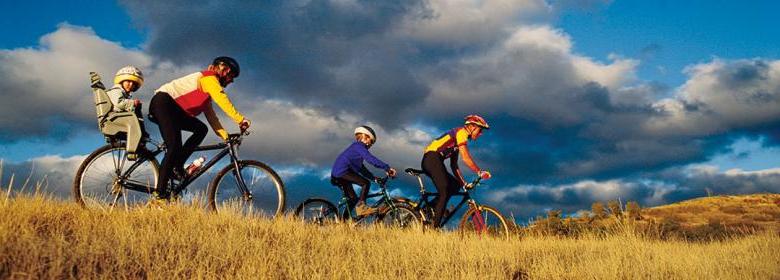You are here

Wear a helmet!
Roll with proper head protection
by Betsy Lynch
 Trying to persuade someone to wear a helmet while biking, boarding, or scootering can feel like an uphill climb. Arguments against putting on protective headgear: helmets are uncomfortable; helmets are ugly; sweaty, messy ‘helmet hair’; I’m only taking a short ride/casual ride/staying on the bike path. Argument in favor of wearing a helmet: it lowers the rider’s risk of a skull fracture, traumatic brain injury — even death.
Trying to persuade someone to wear a helmet while biking, boarding, or scootering can feel like an uphill climb. Arguments against putting on protective headgear: helmets are uncomfortable; helmets are ugly; sweaty, messy ‘helmet hair’; I’m only taking a short ride/casual ride/staying on the bike path. Argument in favor of wearing a helmet: it lowers the rider’s risk of a skull fracture, traumatic brain injury — even death.
Accidents happen. Boy, do they. According to the Consumer Product Safety Commission (CPSC), more than 425,00 bicyclists went to U.S. emergency rooms in 2020; 1,260 of them died. Yet statistical reviews over the last 20 years suggest that helmet use has reduced severe head injuries by 60 percent or more, as detailed in a National Safety Council report.
Materials used in most of today’s helmets are engineered to absorb much of the impact in the event of a fall or collision, protecting your head and brain. Consumers can use the CPSC guide “Which Helmet for Which Activity?” to learn which helmets meet safety standards for cycling, snow sports, skateboarding, in-line skating, horseback riding, water sports, and more at cpsc.gov/safety-education/safety-guides/sports-fitness-and-recreation-bicycles/which-helmet-which-activity.
Helmet choices are not always clear-cut though, like when deciding what to pair with your new electric bike or e-scooter. Keep in mind, the potential for serious brain and facial injuries increases as traveling speeds increase. Experts at Apollo Scooters recommend moped, BMX, or ‘halo’ style helmets for riders navigating in traffic, on pavement, or exceeding 15 miles per hour on e-wheels. Given the risks, you need more head, face, mouth, and eye protection than standard cycling or skateboarding helmets provide.
Helmet care and replacement
Helmets can get dirty and smelly. Hand wash with mild soap and water. Then rinse, air dry, and store in a cool, dry place, away from sunlight. Replace removable pads as needed.
Product safety experts recommend that helmets be replaced every 3 to 5 years to ensure materials retain their shock-absorbing properties. But whenever a helmet takes a hit, it should be retired immediately — even if there’s no obvious damage. Use it as a chance to upgrade. Skiers, boarders, cyclists, and equestrians can take advantage of added safety features like Mips — multi-directional impact protection system, which is a low-friction layer inside the helmet designed to help redirect forces away from the head in a crash. To see which helmets offer the best protection, a lab at Virginia Tech conducts independent impact tests and publishes yearly helmet ratings at helmet.beam.vt.edu/index.html.
Remember, proper fit is essential (see sidebar). A helmet that is too loose or doesn’t sit right on your head can’t do its job. When renting bikes, boards, kayaks, and other equipment, say yes to helmet rental too. It’s a perfect opportunity to consult with pros, try before you buy, and protect your grey matter while enjoying your next adventure.
| MAKE HELMETS A HABIT |
|---|
|
| FIT: THE FOUR S WORDS |
|---|
|
Strap – Straps should be adjusted to form a “V” around the ears, with no more than a finger’s width between the chin strap and chin. Snug – Helmet should fit snugly on the head (not easily shaken off) even when unbuckled. Snap – Snap the buckle before getting underway. ~ Safe Kids Larimer County |
| FIT CHECK |
|---|
|
Get your helmet fit checked by local experts (call for an appointment):
|
| Safe kids larimer county |
|---|
|
Educational classes and events for families to prevent accidental injury. Website resources include the video “Safety in Seconds: Bike Helmet Fit Test” – sklarimer.org/bicyclesafety. Get a voucher for a helmet with a $10 donation – sklarimer.org/bicyclesafety |
 Straight – Helmet should sit straight on the head at approximately eyebrow level in front.
Straight – Helmet should sit straight on the head at approximately eyebrow level in front.